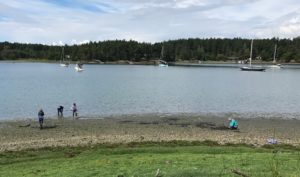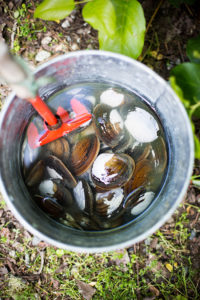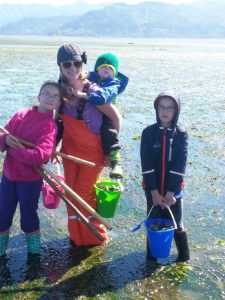Tom and I are used to people hiking in the National Parks where we work. We are accustomed to talking about the history of the park and showing the movie. We give tours and talks and pass out information. But San Juan Island Historical Park has o ne activity that is new to us: clamming.
ne activity that is new to us: clamming.
When we first saw people coming down from the parking lot to the parade grounds carrying shovels and buckets and wearing boots, we weren’t sure what was going on. But we soon realized that they were taking advantage of the public beach on Garrison Bay to dig for clams. In fact, we have a brochure we give out at English Camp that describes where and how to go clamming. It also details the 12 different kinds of clams you can find on the beach.
 Low tide is, of course, the best time to go clamming. We have 13 foot tides in the bay, so there is lots of land exposed at low tide. People can dig for clams from the park dock to Bell Point. They aren’t supposed to dig for clams along our Westcott Bay shoreline because of an agreement with the Westcott Bay Shellfish Company.
Low tide is, of course, the best time to go clamming. We have 13 foot tides in the bay, so there is lots of land exposed at low tide. People can dig for clams from the park dock to Bell Point. They aren’t supposed to dig for clams along our Westcott Bay shoreline because of an agreement with the Westcott Bay Shellfish Company.
Unfortunately there has been a biotoxin warning on shellfish for San Juan County for much of the summer. The Washington Department of Fish and Wildlife tests the water in the county periodically. We aren’t sure how often they check or where, specifically, they check. Some people continue clamming despite the warning. The Westcott Bay Shellfish Company has sold clams all summer. One local couple told us they dig the clams, and then call the Westcott Bay Shellfish Company. The Company tests their water every day, and as long as it is negative for biotoxins, the clams are safe to eat.
 Watching people go clamming looks like so much fun. It is the perfect activity for families because the kids love to find the squirting clams and dig them up. We are told that the geoducks are great for clam chowder and the littleneck clams are the best for steaming. Lots of people consider any kind of clam delicious!
Watching people go clamming looks like so much fun. It is the perfect activity for families because the kids love to find the squirting clams and dig them up. We are told that the geoducks are great for clam chowder and the littleneck clams are the best for steaming. Lots of people consider any kind of clam delicious!
Clamming at English Camp is a first for us in the national parks where we have worked. It is fun to watch and interesting to learn about.
